The kitchen is more than a place where food is stored, prepared and cooked. Like the living room and the dining room, the kitchen has become a popular area to just hang out. Whenever you think of birthday parties, Thanksgiving dinners or the Super Bowl, most likely you’d picture your family gathered in the kitchen. Guests are often entertained here. This is probably why the kitchen has become a “trophy” for most home owners.
Out of the parts of the house, the kitchen is the most remodeled and improved. It is the number one selling feature of a home. Over time, the kitchen has become so expansive and visually desirable.
Considering how homey the kitchen is today, it’s fascinating to think that decades ago, it was one of the least desirable and least welcoming part of the house. Kitchens before were not a place where people like to spend time in – they are often dark, hot, uncomfortable and filled with mess, noises and unwanted smells. Because of this, kitchens tended to be placed away as far as possible from the social and private rooms of the house.
Let’s take a look at the humble beginnings of the kitchen before it contained the best kitchen gadgets we have now:
 Ancient kitchens
Ancient kitchens
Fire was the only key ingredient to the kitchen in the ancient times. Kitchens were just large, poorly ventilated rooms surrounding a central fire. In the ancient Roman empire, large communal kitchens existed because common folks did not have a kitchen of their own. Some had small bronze stoves on which a fire can be lit for cooking. The wealthy had their own well-equipped kitchens separated from the main building in their villa because of the smoke. They have their own slaves operating their kitchen. The fireplace was usually on the floor such that one had to kneel to be able to cook.
Ancient people had no sinks and faucets. They had to fetch water by hand from nearby lakes, rivers or wells and store it in barrels or pots. Later on, simple masonry constructions were used to hold the food and wood.
Kitchens in the Middle Ages
During the Middle Ages, food was placed in metal cauldrons that are hanging above the fire. An open fireplace was situated within a great hall inside the house and served as a primary source of heat, light and of course, food. However, the smoke and soot from the fires were a constant problem for the eyes and lungs. Large homes in Rome used tubes to draw out smoke, until chimneys were appeared in northern Europe during 1100s. However, it was only during the 16th and 17th centuries where chimneys became common in most homes.
With the presence of a chimney, smoke was drawn up and out of the great hall, making it easier to make large fires for cooking in the fireplace. It also separated the great hall, creating two rooms such as the kitchen and the living area.
 Kitchens in the 18th and 19th century
Kitchens in the 18th and 19th century
The functions and design of the kitchen in the 1700s up to 1800s were greatly influenced by the trends in economics and politics of the time. Increased trade between The Americas, Europe and Asia brought new foods and new kitchen demands. The French style of food preparation and cooking influenced the US and England. Elaborate dishes, formal table settings and etiquette were brought to the dining table. A dinner party hosted by a wealthy family was a full-on extravaganza with around 25 dishes per course. Servants in the kitchen were asked not only to cook but also to take care and clean numerous dishware, cutlery, ovens and other cooking tools.
Kitchens were placed on the bottom floor and out of the way of the main entrance. For homes without servants, kitchens were located at the main living quarter, but were still placed in the back of the house and away from receiving rooms such as the living room and the parlor.
The kitchen sink started as a washstand made up of a large bowl or pitcher placed on small tables. Some put a hole on the table and let the large bowl rest there, creating dry sinks.
In terms of cooking, stoves were used during the 18th century. In 1735, French designer Francois Cuvilliés developed one of the earliest wood-burning kitchen stoves called the stew stove. Metal stoves also came into use that century, and one of the earliest examples is the Franklin stove invented by Benjamin Franklin in 1742.
Gradually, smaller stoves were being designed to make it small enough for domestic use and make it more efficient than cooking in a fireplace. In 1834, Philo Stewart created the Oberlin Stove, a compact wood-burning, cast-iron stove. It was a commercial success and became popular by the 1850s in the US.
During the Industrial Revolution, easier and more cost-efficient ways of cooking were invented. Some of the important advancements that changed the look of the kitchen included the invention of electricity, cast iron stove, plumbing, coal and later on, gas.
The growth of coal and iron mining led to a prolific industry in making cast iron stoves for cooking and heating. These stoves could withstand higher heat levels, could be cast into various shapes and sizes, and could also withstand quick temperature swings from hot to cold. For about a century and a half, coal burning became the most prominent way to cook food.
 1900s-1920s: Introduction of gas stoves and ergonomics
1900s-1920s: Introduction of gas stoves and ergonomics
The kitchen during the early 1900s served as a utility work room which often contained the laundry and the sewing machine. It was usually located at the back of the home and out of sight from the entrance, where the housewife would spend most of her day. It was far from being a place for social gathering, but families or housemates tend to huddle in the kitchen during winter to keep warm.
The prevailing use of coal in the kitchen didn’t last long. Eventually, people became concerned about air pollution, deforestation and climate change. Sales of coal stoves declined in the early 1900s and gas became the preferred source of heat. It also allowed stoves and ovens to become lighter and more compact. The gas stove was patented by British inventor James Sharp in 1926.
Kitchens before required constant monitoring throughout the day, especially while cooking. People working in the kitchen needed to constantly adjust the stove and dampers, and add more fuel. They also needed to carry in more water to keep the tank of hot water full.
In the beginning of the century, people kept food cool in ice boxes. It was during the late 1910s when domestic refrigerators were first introduced in the market. The dry sink also evolved, as plumbing systems were integrated with the sink. Before, sinks were made of wood and stone. During the 1900s decade, manufacturers started mass-producing white enameled iron, granite and slate sinks.
White became the color choice for kitchens during the 1910s, as it was easier to clean and creates a sanitary, antiseptic feel. However, designers began to explore other decoration styles for the kitchen by the next decade. Light colors were used to brighten up the kitchen and designs usually had a feminine touch given that the kitchen was a woman’s territory.
Efficiency in the kitchen was also emphasized in the 1920s. American engineer Frederick Winslow Taylor sought to improve ergonomic efficiency in the kitchen by introducing an advanced kitchen design called the Frankfort Kitchen. This tiny kitchen model was designed to make all necessary items accessible within arm’s reach by creating multiple compartments as well as upper and lower cabinets in the kitchen. Yes, this is the standard for today’s kitchen, but back in the day, this idea was revolutionary.
 1930s-1950s: The use of electricity, the rise of the fitted kitchen
1930s-1950s: The use of electricity, the rise of the fitted kitchen
During the 1920s until the 1930s, the electric oven struggled to compete with the gas oven. The first patent for the electric stove was granted to the Copeman Electric Stove Company in Michigan in 1912. The electric stove was a rarity during the 20s, but when the cost of electric power decreased in the 30s, it has been greatly adopted by home owners.
Electricity also paved the way for new appliances like dishwashers, blenders, toasters, microwave ovens and refrigerators to be used widely by the common people. Many of these new time-saving gadgets and labor-saving devices were by-products of war efforts and technology.
Speaking of refrigerators, it was during the 1930s when the Shelvador refrigerator was introduced. Shelvador was the first fridge to have food keepers attached to the door, and its design is still continued to be used today.
In terms of styling, two-toned kitchens became increasingly popular during the 30s to 40s. Kitchens started to embrace a greater touch of fun and colors with bright linoleum and dinnerware.
The most remarkable transformation was the creation of the fitted kitchen, wherein appliances and fixtures were integrated within countertops and cabinetry. This idea helped create a more beautiful, efficient and purposeful interior design, making the workflow easier.
During the 50s, kitchens were delegated from the back of the house to the forefront, where the housewife can interact with family members in the living areas.
More colors were introduced to the kitchen. This was the decade of pink, green yellow or blue kitchen cabinets and countertops, along with fridge, sinks, pots and stoves available in every color of the rainbow. Linoleum and rugs livened up the kitchen floor along with bold floral wallpaper.
 1960s-1990s: The era of the modern designer kitchen
1960s-1990s: The era of the modern designer kitchen
After the World War II, the demand for kitchen technology and equipment increased due to housing boom. Societal changes improved the kitchen, making it more efficient, better organized, easier to work in, and slowly, a place for social activity.
In the 1960s, the feminist movement encouraged more women to join the workforce. With both the wife and the husband in the household working, more time-saving appliances were developed and sold to the market. Refrigerators with freezers, dishwashers and garbage disposals became an increasing need for the busy homemaker.
Gone were the bold and colorful themes of the 50s, and the primary kitchen color was replaced by harvest gold. Linoleum seemed to be present in every kitchen in the 60s. During the 1970s, the favorite harvest gold color was mostly complemented with tones of brown and copper, as well as orange and mustard.
Besides cooking, the kitchen has also become a place to hone culinary skills and to display designer cookware. It was being transformed into a hub for social activity with the introduction of raised bars and kitchen islands, which are still continued today.
More conservative and simpler furniture became the “in” thing again. The trend of having harvest gold kitchen and avocado-colored appliances were tossed out of the window, as the solid wood appearance has made a comeback. Wooden tables and chairs, as well as wallpaper borders became trendy again.
By the 80s and 90s, the kitchen became more and more larger and comfortable to provide adequate space and welcoming ambiance for entertaining guests. More homeowners have turned their kitchen into showrooms – displaying stuff like wine, Chinese porcelain, pots, pegboards and cookbooks into shelves to show off to guests. The open kitchen came to existence, giving birth to the trophy kitchen.
 21st century: The era of smart, trophy kitchens
21st century: The era of smart, trophy kitchens
Kitchens were increasingly used for projecting social status, with high-end appliances like induction cookers and high-speed ovens placed in kitchen islands to impress visitors. Utilizing advanced technology like smart kitchen appliances is a plus factor. Smart kitchens are here to make you savvier and more organized.
The Internet influenced culinary inventions as well. Now, we can use our own smartphones to control our smart appliances in the kitchen. It has been the most radical development to food storage and preparation yet.
A smart refrigerator can confirm whether you are running out of eggs or not while you’re at the grocery store. It has a built-in speaker and touch screen on the door, which can alert you of the foods that are about to expire. This feature can also project what’s playing on your smartphone so you can distract your little toddler while you are preparing dinner. The temperature on the smart refrigerator can also adjust automatically, depending on the types of food kept inside the fridge.
To top off the intelligent fridge, the smart oven comes in. It can also offer tips on how to cook something. Its touch screen can suggest the right temperature range and cooking time for a dish. To add to that, the smart oven can also remember specific settings of your preferred cooking method so that you don’t need to load it up in your memory anymore.
In terms of design and aesthetics, recessed cabinet lights and dropped lighting over the kitchen islands are a common feature. Stainless steel and granite is a mainstay. The main rule is to keep it sleek and uncluttered.
The kitchen has come a long way since it was plainly composed of a fireplace in the middle of the room. Now, it has become a source of pride and satisfaction by many home owners. If you are seeking to give your kitchen a fine upgrade, don’t settle for less and get only the top rated kitchen gadgets in the market. Read a lot of kitchen gadgets reviews and look for kitchen gadget deals before deciding – for sure you’ll be thrilled to see your own trophy kitchen in the near future!


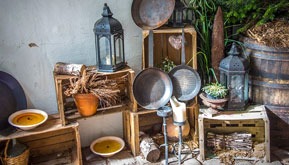 Ancient kitchens
Ancient kitchens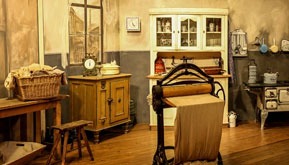 Kitchens in the 18th and 19th century
Kitchens in the 18th and 19th century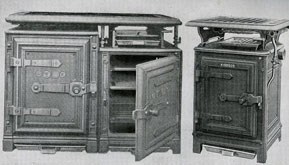 1900s-1920s: Introduction of gas stoves and ergonomics
1900s-1920s: Introduction of gas stoves and ergonomics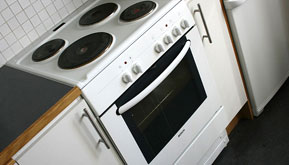 1930s-1950s: The use of electricity, the rise of the fitted kitchen
1930s-1950s: The use of electricity, the rise of the fitted kitchen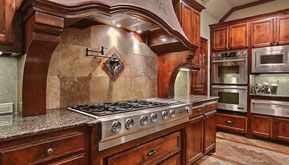 1960s-1990s: The era of the modern designer kitchen
1960s-1990s: The era of the modern designer kitchen 21st century: The era of smart, trophy kitchens
21st century: The era of smart, trophy kitchens